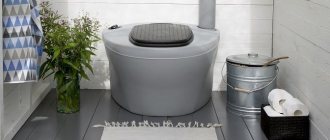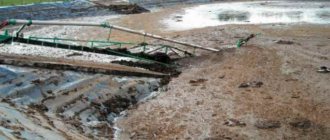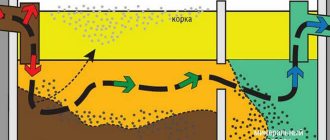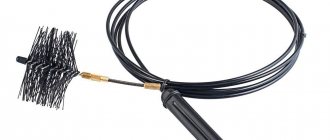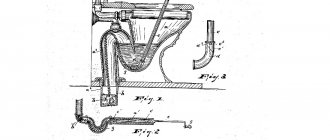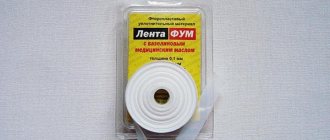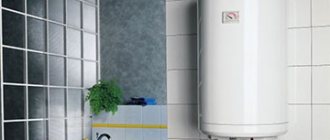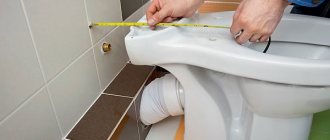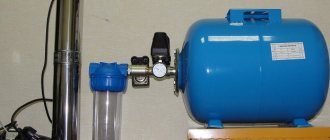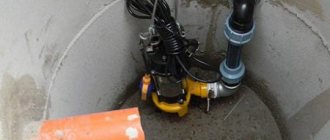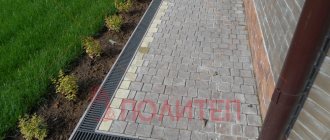A convenient, small-sized solution for a summer house or not fully equipped premises would be a dry closet in a house without a sewer system. It is effective and simple, does not require complex maintenance. There are many design options and models, differing in price and method of waste disposal.
The popularity of dry toilets is constantly growing, despite the limited functionality of the device. It will not replace conventional sewerage, limiting itself to the treatment of physiological waste. To drain drains from showers, washing machines and other plumbing fixtures, you will have to build a separate system. However, a dry toilet allows you to effectively solve the most pressing and urgent problem. This makes it a popular and convenient device.
What it is
Let's look at what a dry closet looks like for a house without a sewer system. Externally, this is a compact set that includes a toilet bowl, a container on which it is installed and a unit that performs the function of a flush cistern. Most models work autonomously, but there are universal or combined designs. A special feature of the device is biological or chemical waste disposal. In addition, there was a complete absence of the bad smell characteristic of ordinary cesspools.
A dry toilet does not solve the problem of drainage from plumbing. It is intended for the reception and treatment of physiological waste only. To drain liquids from other devices, you will need a separate, independent line. This is a feature of the dry closet, which must be taken into account when choosing a method of waste disposal.
The design of most devices resembles the usual design of a floor-mounted compact toilet, only instead of connecting to the drainage line, there is a container for collecting and processing waste in the lower part. It deodorizes and utilizes organic matter. This is how all indoor dry toilets are designed and do not require sewerage. There are more complex designs that can simultaneously operate autonomously and connected to the system. As a rule, the choice of a particular device is determined by several criteria:
- expected working conditions;
- amount of waste;
- container cleaning frequency;
- availability of electricity and running water in the house;
- financial capabilities of the user.
As a rule, any indoor dry toilet without sewerage is not fundamentally different from the street stalls familiar to all city residents. It is not equipped only with outer walls, and the device itself functions in the same way. It will not be able to become a full-fledged alternative to the central sewer system, but it effectively solves the problem of waste disposal.
Plot
-2 votes
+
Vote for!
—
Vote against!
Installing a peat dry closet at your dacha has a number of significant advantages. First of all, this room has no unpleasant odors, is distinguished by its attractive appearance, ease of use and affordable cost. Therefore, if your summer cottage does not yet have a toilet, we recommend choosing this option. We will consider the features of installing a peat dry closet below.
Table of contents:
- Peat dry closet - characteristics and principle of operation
- How to install a peat dry closet: features of choosing a device
- Do-it-yourself composting toilet for your dacha: peat composting toilet filler
- How to properly install a peat dry closet for a summer residence
Peat dry closet - characteristics and principle of operation
Considering a peat-based toilet from an environmental point of view, it can truly be called a dry toilet. Since it is based on an organic filler in the form of peat. The appearance of this toilet has the shape of a toilet bowl consisting of two elements. The upper part of the toilet is intended for installing filler in it, and waste gets into the lower part.
By rotating a specially equipped handle on the toilet, the filler covers the waste, working through the flushing system. At the same time, water in this dry closet is not used at all. In order to dispose of waste, it is necessary to equip a special pit for its processing. After one or two years of using the toilet, the waste is used as fertilizer.
The peat dry closet has the following advantages:
- the possibility of installation both outdoors and indoors, while it has special drainage and ventilation that prevent the appearance of unpleasant odors;
- compact dimensions allow you to install a toilet in the smallest room;
- the container is emptied quite rarely, approximately once a month, depending on the number of people using the toilet;
- during the operation of the dry closet, it is possible to obtain a natural biological fertilizer called compost;
- savings in consumables and physical effort in constructing a toilet, compared to a standard pit toilet;
- no additional costs for operating a dry closet;
- affordable price.
Despite this, a peat-based dry closet has the following disadvantages:
- when installing a dry closet, it is necessary to properly organize the drainage and ventilation systems, while the height of the exhaust pipe is about 400 cm; to remove unpleasant odors, it is also necessary to take care of installing a fan;
- it is preferable to install a dry closet inside a heated room, since in the winter there is a risk of the insulation freezing;
- The size of the dry closet is slightly larger than that of a regular toilet.
Among the main components of a dry closet operating on peat, we note the following elements:
- toilet lids and seats;
- containers for peat;
- body part;
- a hose through which liquid waste is drained;
- ventilation pipe;
- waste collection containers.
Among the main components of a peat dry closet, two tanks should be distinguished - upper and lower. Waste accumulates in the lower container; it has the shape of a retractable container, with a volume of 45 to 150 liters.
The upper container contains peat, which covers human waste products after emptying. In order to remove unpleasant odor from the toilet, a ventilation pipe about 350-400 cm high is installed behind it. The storage tank also has a drainage system and additional filters. Special flaps close the storage tank while the toilet is not in use for its intended purpose.
The peat dry closet is quite widely used for elderly people; some models are equipped with special wheels that facilitate the process of getting rid of waste products.
The principle of operation of this toilet is as follows: after emptying, the products fall into the lower tank, then you should turn the handle, which ensures that they are covered with peat. At the same time, waste should be sprinkled evenly over the entire surface. By turning the handle, you have the opportunity to control the amount of peat poured onto the surface.
Most often, a special type of peat is used as a filler, intended for use in dry closets. Under no circumstances use regular peat, as it does not contain the microorganisms that convert feces into fertilizer.
After sprinkling with peat, the process of mineralization begins, that is, waste processing. At the same time, no unpleasant odor is released as a result of this process.
This peat composition is also capable of absorbing liquid. If the toilet is used for a small family of one or two people, then the liquid is quickly processed by the same microorganisms. Otherwise, the installation of special filters and the arrangement of a drainage system will be required.
Through the drainage system, the liquid seeps into the compartment and a specially installed hose, and through it is discharged into the sewer. At the same time, try to position the hose at a slight slope.
The time it takes to empty a peat dry closet depends on the frequency of its use. Most often, its owners themselves adapt to the process of filling it and choose the optimal emptying option.
This version of the toilet is called a dry toilet, due to the fact that during its operation no chemicals are used, and in the end it is possible to obtain excellent fertilizer.
How to install a peat dry closet: features of choosing a device
When choosing a dry closet for your dacha, focus on the following criteria:
- pay attention to the material from which the toilet is constructed, it is better to give preference to frost-resistant plastic, such a toilet can be installed both outdoors and indoors without any problems;
- inspect the dispenser, as some models have problems with its use;
- the presence of a sealed lid will protect the room from both unpleasant odors and flies;
- The volume of the storage tank must correspond to the needs of the family; for four people, a tank measuring 100 liters or more is sufficient.
When choosing a peat or liquid dry closet, we recommend choosing the first option.
In relation to the principle of operation of dry closets, they are:
- peat;
- devices powered by electricity;
- liquid.
Electric dry closets have a rather complex design; they require a power supply to ensure their functionality.
A liquid dry closet requires a large amount of water and the need to drain it. At the same time, quite expensive preparations are used as fillers in such toilets.
A peat toilet is the best option for a summer residence, both in terms of affordable cost and performance characteristics. The device does not require water or expensive fillers to operate, and in the end it is possible to obtain an excellent fertilizer for the garden or vegetable garden.
Most often on the market there are dry closets of Russian or Finnish origin. The first ones are less expensive to operate. The second ones have the following advantages:
- attractive appearance of the equipment;
- high capacity of storage tanks;
- good level of ventilation;
- The seats are made of foam instead of plastic, higher comfort and ease of use.
Do-it-yourself composting toilet for your dacha: peat composting toilet filler
We suggest that you familiarize yourself with the option of independently constructing a peat dry closet for your dacha. First of all, choose a place to build. Since the dry closet does not require the construction of a cesspool and pumping it out, the choice of location is unlimited. It is better, of course, if the toilet is located behind the facade of the house and five meters from the residential building.
It is possible to build such a dry closet inside the house, but in this case, drainage and ventilation must first be arranged. The simplest option would be to build a dry closet in the form of a seat with two types of containers, for recycling waste and for storing peat. To make the container, choose materials that are not susceptible to corrosion, such as plastic. It is possible to use a large bucket or other container.
You will also need timber and plywood. With their help you can build a toilet seat. In the process of work, you will need the following tools:
- electric jigsaw;
- building level;
- roulette;
- hammer;
- screwdriver.
Initially, you should determine the dimensions of the seat for the dry closet and make blanks from timber. Plywood will be used for cladding the structure. Pre-treat all parts with moisture-resistant and antiseptic compounds that will protect them from moisture.
The design should ultimately resemble a box that opens from the top using a lid. Next, make a hole in the top of the box so that you can tightly install the waste storage tank into it. Use a jigsaw to cut the hole. After this, the wooden container is sanded and painted. Install the lid on the dry closet. It should close tightly, only in this case the unpleasant smell will not get into the street. Place a bucket containing peat and a shovel near the toilet. Thus, a homemade dry closet for the dacha is being manufactured.
If more than two people use the toilet, then care must be taken to create a drainage system. To do this, connect a hose to the waste container and lead it to the drainage point.
To obtain high-quality fertilizer, it is necessary to use the dry closet correctly. As it fills, the storage tank is taken to a special pile where waste is processed into compost. After emptying the container, it is necessary to wash and dry it, so it is advisable to stock up on another additional storage tank. It is recommended to buy special peat for the dry closet, since it contains special microorganisms that process waste.
How to properly install a peat dry closet for a summer residence
When installing a dry closet at your dacha, you must first of all become familiar with the technological aspects of the work. After all, the comfort of using a dry closet will depend on the correct organization of ventilation in the room.
If the toilet is installed inside the house, then initially it is necessary to install a ventilation pipe that will pass through the roof of the building or through its wall. Next, the drainage hose is removed through the ditch and a drainage system is installed to remove the liquid. At the same time, peat is poured into the upper compartment of the toilet and the toilet is installed on the floor, fixed to it with screws.
In order to avoid unpleasant odors in the room during the operation of the toilet, it is necessary to periodically wash the storage tank as it is emptied. Also, with the help of sanitary liquid it is possible to prevent the appearance of odor.
Pay special attention to the ventilation system of the toilet. If it is used up to twenty times a day, then a ventilation hose with a diameter of 4 cm is sufficient. In this case, natural ventilation in the room plays an important role. If the number of visits to the toilet exceeds forty and reaches sixty, then in order to equip the ventilation system you will need to install two hoses - with a diameter of 4 and 10 cm. With even more visits to the dry closet, in addition to two hoses, you will also need to install a forced ventilation system in the form of an exhaust fan.
In any case, all the rules and regulations for installing a peat dry closet are clearly described in the instructions for its use. Before using the toilet, place a small layer of peat on its bottom, so that after emptying it, the tank will be easier to clean.
Peat dry closet video:
When do you need a dry closet?
Construction of a full-fledged sewer system in a country house or in a private house is not always possible. When drawing up a system design, you have to maintain certain distances to buildings, wells or boreholes, and other objects. Often, the configuration of the site, the proximity of neighboring buildings, and other factors prevent the fulfillment of all requirements. Some owners deliberately violate the requirements, seeing no other way out. This is fraught with quarrels with neighbors and unpleasant conversations with regulatory authorities. A dry toilet without sewerage, which is not connected to communications and can be located at any convenient point on the site, helps solve the problem.
The best option for using the device is considered to be a summer cottage without permanent residence. If there is no drainage system, electricity or water supply is not connected, you will have to use either an antediluvian toilet or buy a dry toilet.
Many apartment owners use the device during renovations. Sometimes the work drags on for a long time, and the drainage system (or water supply) is turned off, and it is not known when it will be started. Installing a compact device allows you to provide a temporary solution to the problem, and after repair, the device can be transported to your dacha or country house.
What designs of toilets for summer cottages exist?
Such buildings can be divided into several varieties suitable for a summer residence:
- toilet house with cesspool;
- standard powder closet;
- factory biotool.
Toilet house with cesspool
For such a structure, a foundation pit is first dug. Then they build a cesspool by strengthening the walls with concrete rings, bricks, monolithic concrete, or installing a plastic container in the pit.
A toilet house made from scrap material is installed above the pit, in which a pedestal or toilet seat is placed. Such a toilet design for a summer house involves the accumulation of waste in a cesspool.
To eliminate the smell spreading from the cesspool, install a ventilation pipe
If the structure is not sealed, liquid waste partially seeps into the soil or evaporates.
Filling a sealed pit occurs faster. When sewage reaches a certain level, it has to be removed. Cleaning is carried out either independently using a pump, or by calling a sewer truck.
Powder closet - a house without a cesspool
A house is also built for a powder closet, but without a cesspool. In this version of the country toilet, waste is collected in a container located under the toilet seat.
For greater convenience, two “different-sized” tanks are installed. Small holes are made in the smaller one and inserted into the larger one, on the side of which a round outlet is made and a drainage hose is installed. It will drain excess liquid into the ground or into the drainage system.
A container for the filler is placed next to the toilet seat. This could be sawdust, peat or dry soil.
Despite the fact that the filler partially suppresses odors, the powder closet requires the installation of a ventilation pipe
After visiting the toilet, the waste is sprinkled with litter. This reduces unpleasant odors and promotes the decomposition of sewage. As the tank fills, it is taken to the compost heap.
The scheme for constructing a powder-closet-type toilet in a country house should take into account the method of obtaining the container. Basically there are only two of them. In the first case, the reservoir is removed from the toilet seat by lifting the seat.
In the second, a small door is built at the back of the building, by opening which you can remove the drive.
If you don’t want the hassle, buy a dry closet
For those who do not have the desire or time to build a toilet, there are ready-made products. Manufacturers of dry closets have already taken care of everything. All you have to do is choose the appropriate option and install it in your room or house. If funds allow, you can buy a toilet along with a stall.
Whatever type of toilet is chosen, it is advisable to begin its construction by drawing up a diagram. It is necessary to indicate the dimensions of the structure and the location of all components. For example, the construction plan for a country toilet with a cesspool should be drawn up taking into account the width and depth of the pit.
Advantages and disadvantages
A dry toilet in a house without a sewer system shows serious advantages:
- there is no need to build any additional structures, carry out excavation work, or spoil a landscaped area with green spaces;
- choosing a location for installation does not require taking into account any requirements. If necessary, the device can be freely moved to another point;
- efficiency, simplicity of design;
- no bad smell;
- modern design of devices;
- a large number of design options;
- ease of maintenance, ease of cleaning the device.
There are also disadvantages:
- the price of the device is quite high;
- connection to the ventilation pipe is required;
- drainage is needed;
- Many models require power supply.
Despite the existing disadvantages, dry toilets are in demand due to their compactness and high efficiency. In addition, the cost of constructing a stationary sewer system exceeds the price of compact models, which increases the demand for dry toilets.
Also read: Is it possible to clean the sewer with electrolyte: how to use it, can it be rinsed?
We save the environment with a peat dry toilet for our summer cottage
Then the base under the floor is covered with sand and compacted thoroughly.
For sewage use pipes with a diameter of 50 mm
To keep the room warm enough, foam is laid on top of the sand.
The base is reinforced and filled with mortar.
Polyfoam makes the room warmer, which allows it to be used even in cool weather
When pouring the solution under the shower, do not forget to make a slight slope
Construction of walls and roof of the structure
A beam is fixed on top of the foundation around the perimeter.
To do this, use long pins with a diameter of 1 cm, or reinforcement.
Roofing material is laid under the timber for waterproofing
Then they build a frame for the walls and a roof sheathing from edged boards (0.5 × 1 m).
During the construction of walls you need to use a level
When making the roof sheathing, extend it beyond the gables by at least 0.3 m
The roof is sheathed with edged boards.
Frontal boards are attached to the end parts of the sheathing.
For the strength of the lathing, metal corners are used
After which they begin laying the roof.
For the roof, you can use soft bitumen tiles, slate or other covering
After finishing work on the roof, wind protection and wall sheathing are installed.
The sheathing of the structure is necessary to ensure ventilation
The outside of the building is sheathed with edged boards (0.22×1 m).
Doors are made from it (2.1×0.9 cm). Windows are inserted and trims are sewn on.
The sheathing will be sheathed with edged boards. Wooden elements must be treated with an antiseptic
A large container is dug under the sewer drain and a pipe is connected.
The sewage container should protrude slightly above ground level.
This will prevent rainwater from entering it.
Varieties
A dry toilet in a house without a sewer system is chosen based on its operating conditions. They are usually divided into portable and stationary. The first ones are compact, light in weight and can be used in small spaces. The latter need to be connected to ventilation and drainage, and power supply.
Different designs are equipped with their own types of fillers. There are different types of devices on sale:
- electrical;
- liquid or chemical (including portable or cassette);
- peat.
Peat models are simpler and more economical. To dispose of waste, they use peat with special microflora. Regular peat will not work, as it does not have the necessary bacteria.
Chemical devices quickly and almost completely process organic matter. Several types of active reagents are used (ammonium, formaldehyde or biological), which are selected based on the point of waste discharge. Biological ones can be poured into a compost pit, the rest require isolated discharge points.
Electrical appliances appeared relatively recently. They are equipped with compressors, a drainage system and other components. For the operation of such structures, a connection to communications is required, so they must be classified as stationary devices.
The principle of operation of toilets using peat components
Ordinary peat is used as a filler for dry toilets.
The active substance in the form of peat filler has excellent absorption. It is capable of absorbing large amounts of waste. Moreover, this ability is expressed in specific proportions - just one kilogram of peat easily absorbs 10 liters of waste! In the process of processing liquid waste with the participation of peat, compost is formed that is beneficial for soil fertility. This kind of home compost production is very important for summer residents, especially since it almost completely eliminates the smell from processed products and preserves useful components.
Externally, the Finnish peat toilet for a summer residence resembles a regular toilet, however, its formats can be arbitrary. Also, the dimensions of the dry closet also vary.
What to pay attention to
When buying a dry closet for an apartment without a sewer system, you must first consider its functionality. Required options:
- flush unit. The most effective models are those with double-sided flushing, where the entire area of the bowl is completely washed;
- pressure valve. Eliminates water splashing;
- storage tank loading indicator, notifying about cleaning time;
- storage volume. The more people use the dry closet, the larger the tank is needed;
- dimensions. It is necessary to think in advance whether it will have to be transported in a car, or installed in a cramped room;
- connection to the sewerage system in the house.
A controversial type of design has become a dry closet with a sewer connection. If it exists, it is easier to build a normal bathroom and not use intermediate devices. However, many owners use this method to reduce the volume of wastewater in a septic tank or cesspool. This allows you to increase the interval between pumping out the tank.
Installation and operation
Installing peat toilets in your summer cottage is a very simple process, you can handle it yourself. Before you start assembling the structure, you should decide on the location of its installation. For full functioning of the dry closet, install it on a flat surface strictly horizontally.
You will probably be interested in reading about whether it is possible to fertilize your garden with feces.
Next comes the installation of the ventilation pipeline. To prevent unpleasant odors from accumulating in the toilet stall, it is best to route the pipeline up to the roof.
It is desirable that the ventilation pipe be installed without bends, which during operation will create obstacles to air flow.
The next stage of installation of a dry closet will be the installation of a liquid waste removal system. The drainage hose must exit the storage tank into the cesspool without kinks or bends. Instead of a pit, you can use a canister or other convenient container into which liquid fractions will flow freely.
The final stage of installing peat toilets will be filling the peat tank - manufacturers recommend pouring the mixture into no more than a third of the tank’s volume. The main rule of operation is to cover the waste with a small layer of peat after each visit to the dry closet.
Country “rooms of reverie”
What is the first to be built on our domestic “haciendas”? That's right, a wooden booth, which, although it sticks out and is visible from everywhere, provides a person with an enclosed space, fencing him off from the rest of the world at the right moment. For the time being, this building is quite enough, and visiting it even has a touch of romance.
After getting used to it and losing its novelty, all the shortcomings of this structure become clearly visible: it’s too far to run to it, you don’t want to show your neighbors your physiological cycle, but most importantly, it’s not clear what to do with what has accumulated in the pit. Although it is called a cesspool, I really don’t want to do this, and if I start such work, I would like to reduce the severity of the “indescribable sensations” to a minimum.
The solution to the problem was found according to the principle “abroad will help us,” although the Great Schemer had something completely different in mind. From prim Europe, where the use of “bushes” is bad manners, the bio-toilet for the dacha has come to our domestic spaces. Why the prefix “bio” is used in the name of this device is not entirely clear, since the essence of the process remains the same. Most likely, what was meant was that it is used outside the city, and waste disposal occurs with the least damage to the environment.
This is a compact device that, if desired, can be installed right at home - it is no larger than a bench in size.
Waste is accumulated in it and disposed of in one of three ways:
- Composting.
- Chemical decomposition.
- By drying.
You can use a dry closet not only at the dacha. It is installed in small displacement cabin boats and car trailers. This is a good help for those who care for the sick or disabled. The biggest advantage of this device is that waste can be disposed of without offending your human dignity.
The home dry toilet, with all its advantages, also has a number of disadvantages.
The main one is that it cannot work without a certain set of accessories.
- Composting peat mixtures,
- chemical breakers,
- bags,
- napkins,
- filters...
The list of necessary and useful little things is very wide. All of them are quite expensive, and you can buy them without problems only in large centers of civilization. In rural stores, the mention of them only causes bewilderment.
However, its benefits and the amenities provided are so great that it is worth showing persistence in acquiring all the necessary set of “essentials” for its operation, and not being particularly stingy.
An overview of the main types and popular brands of this wonderful device in every sense will help you answer the question: how to choose a dry closet for a private home.
Voting for the best dry closet
Which dry toilet for a private home would you choose or recommend?
Bioecology Pragma
0.00 % ( 0 )
Bioecology Ecolight Summer Resident
33.33 % ( 1 )
Separett Camping 1165
33.33 % ( 1 )
Piteco 905
33.33 % ( 1 )
Thetford Porta Potti 565E
0.00 % ( 0 )
Enviro 10
0.00 % ( 0 )
Thetford C224-CW
0.00 % ( 0 )
BioLet 25
0.00 % ( 0 )
Separett Villa 9011
0.00 % ( 0 )
Separett Flame 8000
0.00 % ( 0 )
BIOFORCE COMPACT WC 12-10
0.00 % ( 0 )
